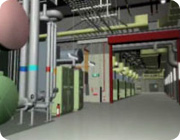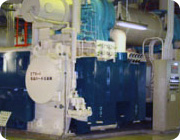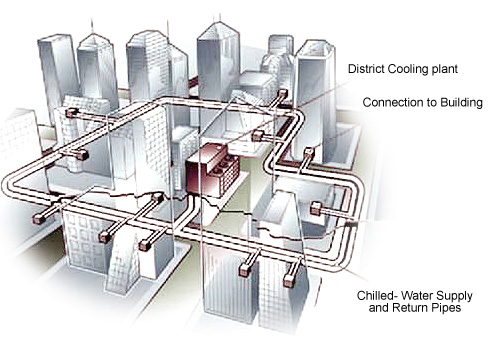BUILDING
District Cooling System (DCS)
What is District Cooling?
Basically, a district cooling system (DCS) distributes cooling capacity in the form of chilled water or other medium from a central source to multiple buildings through a network of underground pipes for use in space and process cooling. Individual user purchases chilled water for their building from the district cooling system operator and do not need to install their own chiller plants. For this system, a central chiller plant, a pump house and a distribution pipeline network are required.
The DCS is an energy-efficient air-conditioning system as it consumes 35% and 20% less electricity as compared with traditional air-cooled air-conditioning systems and individual water-cooled air-conditioning systems using cooling towers respectively. In some countries that have substantial heating demand, the plant can also be designed to supply hot water to form a District Heating and Cooling System (DHCS).
A typical DCS comprises the following components:
- Central Chiller Plant - generate chilled water for cooling purposes.
- Distribution Network - distribute chilled water to buildings
- Consumer Substation - interface with buildings' own air-conditioning circuits.
Central Chiller Plant
Chilled water is typically generated at the central chiller plant by compressor driven chillers, absorption chillers or other sources like ambient cooling or “free cooling” from deep lakes, rivers, aquifers or oceans.
Groups of large and energy-efficient water-cooled chillers are usually installed in a central chiller plant to take advantage of the economy of scale and the cooling demand diversity between different buildings within a district. Sea water condensers or fresh water cooling towers can be utilized to reject waste heat from the central chillers.


Distribution Network
District chilled water is distributed from the cooling source(s) to the user stations through supply pipes and is returned after extracting heat from the building’s secondary chilled water systems. Pumps distribute the chilled water by creating a pressure differential between the supply and return lines.
Consumer Substation
The interface between the district cooling system and the building cooling system is commonly referred to as consumer substation. The consumer substation would usually comprise of air handling units, heat exchanger and chilled water piping in the building. A consumer substation is required in each user's building to connect the DCS distributed chilled water pipe to the building. Inside the consumer substation, devices called heat exchangers are installed to transfer heat between the chilled water supply of DCS and the air-conditioning system of the user building. The consumer substation could be designed for direct or indirect connection to the district cooling distribution system. With direct connection, the district cooling water is distributed within the building directly to terminal equipment such as air handling and fan coil units, induction units, etc. An indirect connection utilizes one or multiple heat exchangers in between the district system and the building system.
